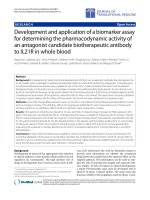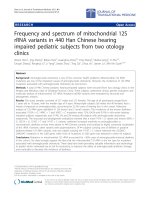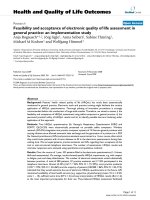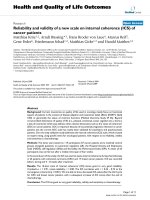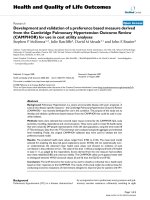Báo cáo hóa học: " Design and Fabrication of Fiber-Optic Nanoprobes for Optical Sensing" pdf
Bạn đang xem bản rút gọn của tài liệu. Xem và tải ngay bản đầy đủ của tài liệu tại đây (346.47 KB, 6 trang )
NANO EXPRESS Open Access
Design and Fabrication of Fiber-Optic
Nanoprobes for Optical Sensing
Yan Zhang
1,2
, Anuj Dhawan
1,2
, Tuan Vo-Dinh
1,2,3*
Abstract
This paper describes the design and fabrication of fiber-optic nanoprobes developed for optical detection in single
living cells. It is critical to fabricate probes with well-controlled nanoapertures for optimized spatial resolution and
optical transmission. The detection sensitivity of fiber-optic nanoprobe depends mainly on the extremely small
excitation volume that is determined by the aperture sizes and penetration depths. We investigate the angle
dependence of the aperture in shadow evaporation of the metal coating onto the tip wall. It was found that
nanoaperture diameters of approximately 50 nm can be achieved using a 25° tilt angle. On the other hand, the
aperture size is sensitive to the subtle change of the metal evaporation angle and could be blocked by irregular
metal grains. Through focused ion beam (FIB) milling, optical nanoprobes with well-defined aperture size as small
as 200 nm can be obtained. Finally, we illustrate the use of the nanoprobes by detecting a fluorescent species,
benzo[a] pyrene tetrol (BPT), in single living cells. A quan titative esti mation of the numbers of BPT molecules
detected using fiber-optic nanoprobes for BPT solutions shows that the limit of detection was approximately
100 molecules.
Introduction
The emergence of nanotechnology opens new horizons
for nanosensors and nanoprobes that are suitable for
intracellular measurements. Nanosensors provide critical
information for monitoring biomolecular processes
within a single living cell, thus could provide great
advances in biomedical research and clinical applica-
tions. Fiber-optic nanosensors with nanoscale dimen-
sions are capable of sensing intracellular/intercellular
physiological and biological parameters in submicron
environments. Tapered fibers with dist al diamet ers
between 20 and 500 nm have been demonstrated for
near-field scanning optical microscopy (NSOM) [1,2].
Chemical nanosensors were developed for monitoring
calcium and nitric oxide, amo ng other physico-chemi-
cals in single cells [3,4]. Vo-Dinh and coworkers have
developed nanobiosensors to detect biochemical targets
inside living single cells [5-12]. Fiber-optic nanoprobe
promises to be an area of growing research that could
potentially provide an imaging tool for monitoring
individual cells and even biological molecules. Single-
molecule detection and imaging schemes using nanofibers
could open new possibilities in the investigation of the
complex biochemical reactions and pathways in biological
and cellular systems leading to impor tant applications in
medicine and health effect studies.
Optical nanotips were first developed as scanning probes
in near-field optical microscopes [2]. Such nanoprobes can
achieve resolution as high as l/50, where l is the wave-
length of light [1]. It is important to control aperture size,
taper shape, and metal coating to achieve a better perfor-
mance [13]. The fiber-optic probes were fabricated by
laser-heated pulling or chemical etching [14-16]. Laser-
pulled fiber tips can achieve diameters smaller than 50 nm
with small cone angles [14]. Chemical etching tips have
larger cone angles and similar apex sizes [15]. However, it
is often difficult to control the etching process. The side of
the fiber was further coated with silver, aluminum, or gold
films to confine the light [9,14,17]. Traditional manufac-
turing processes still limit the quality of metal-coated fiber
probes. Optical throughput of pulled nanoprobes is limited
by the sharp taper angle. Chemical-etched tips have higher
throughput; however, they do not have a flat distal end as
laser-pulled ones which are difficult to form well-defined
nanoapertures in shadow evaporation. Moreover, shadow
evaporation often leads to either complete or irregular
coated tip. Grainy structures of metal thin film increase
* Correspondence:
1
Fitzpatrick Institute for Photonics, Duke University, Durham, NC 27708, USA.
Full list of author information is available at the end of the article
Zhang et al. Nanoscale Res Lett 2011, 6:18
/>© 2010 Zhang et al. This is an Open Access article distributed under the terms of the Creative Commons Attribution License
(http://creative commons.org/licenses/by/2.0), which permits unre stricted use, distribution, and reproduction in any medium, provided
the original work is properly cited.
the distance between the aperture and the sample, which
reduce the resolution and intensity. It is also easy to form
pin holes at the tapered region that could cause light-
leaking. The aperture deviates from ideal circular shape
because of grains. A quantitative analysis of probe trans-
mission efficiency becomes difficult. Focused ion beam
(FIB) fabrication of nanostructures has been applied on
optical fibers for chemical sensing [18]. FIB milling for
nanostructure formation allows precise control of size and
shape in nanometer accuracy. This paper deals specifically
with the metal coating on the formation of nanoaperture
at the tip end. Coating materials and angles greatly affect
the quality of the nanoprobe. By combining with focused
ion beam milling, nanoprobes with well-defined aperture
as small as 200 nm have been obtained. We investigate the
capacity of the nanoprobes by detect benzo[a]pyrene tetrol
in living cells.
Experimental Procedures
Nanoprobe Fabrication
Optical nanoprobes were fabricated through laser
pulling method, which consists of local heating of an
optical fiber (Polymicro Technologies FVP400440480)
using a laser and subsequently pulling the fiber apart.
Fabrication of nanosensors requires techniques capable
of making reproducible optical fibers with submicron-
size-diameter core. Figure 1 illustrates the experimental
setup for the fabrication of nanofibers using the micro-
pipette puller (Sutter Instruments P-2000) [9]. As the
laser pulling process is a time-dependent heating effect,
laser power, timing of pulling, velocity setting, and pull-
ing force all contribute to the taper shape and tip size.
Since transmission efficiency is hi ghly dependent on the
taper shape, it is crucial to control the tip shape in the
fabrication of high-quality nanoprobes.
The sidewall of the tapered end was then coated with a
thin layer of metal, such as silver, aluminum, or gold to
prevent light leakage of the excitation light on the
tapered side of the fiber. An array of fiber probes was
attached on a rotating motor inside a thermal evapora-
tion chamber ( Quorum Technologies E6700). The rota-
tion rate was controlled by a microcontr oller board
(Parallax). While the probes were rotating, the metal was
allowed to evaporate onto the tapered side of the fiber tip
to form a thin coating. The nanoaperture was fo rmed
through shadowed e vaporation as the fibers were tilting
away from the source. The nanoprobes were character-
ized with scanning electron microscopy (FEI XL30).
In order to fabricate well-defined fiber-optic nano-
probe tips, we employed focused ion beam (FIB) milling
of nanoapertures in the metallic films deposited on
tapered tips of optical fibers. Before carrying out FIB
milling, the optical fibers were coated with metallic
films (aluminum, silver or gold) using electron beam
evaporation (CHA Industries Solution E-B eam). During
the evaporation process, t he fiber-optic tips faced the
metal s ource to ensure that the fiber side walls and the
tips were completely covered with a thin metallic layer
(100–150 nm). The sample mount was rotated to
improve uniformity and the thickness of the m etallic
film was monitored by a quartz crystal monitor. The
deposition rate was varied between 0.05 and 0.2 nm s
-1
at a chamber pressure of ~3 × 10
-6
Torr for the electron
beam evaporated films.
A Hitachi FB2100 focused ion beam milling machine
with a gallium ion source was used to fabricate the
nanoapertures on the fiber tips. Beam currents and
accelerating voltages of 0.01 nA and 40 keV energy were
typically used. The desired nanostructures were milled
by rastering the ion beam and employing a beam blan-
ker. The beam blanker shuts on and off according to a
8-bit grayscale, 512 by 512 pixel image file. Tapered
optical fiber tips with nanoapertures were fabricated by
employing FIB milling at magnifications varying between
3000× and 18000× depending on the desired minimum
aperture size. To form metallic nanostructures on the
tips of optical fibers, a special fiber holder that could fit
in the FIB stage was fabricated.
Optical Measurement
The optical measurement system used for nanoprobe is
schematically illustrated in Figure 2 . For nanoprobe
measurements, the 325 nm line of a HeCd laser
Figure 1 Fabrication of nanofibers by laser pulling.
Figure 2 Instrumental system for fluorescence measurements
using nanoprobes.
Zhang et al. Nanoscale Res Lett 2011, 6:18
/>Page 2 of 6
(CVI Melles Griot, 15 mW laser power) was focused
onto a 400 μm delivery fiber. A tapered fiber was
coupled to the delivery fiber through a capillary tubing
and was secured to the micromanipulators (Narishige
MLW-3) on a Zeiss Axiovert 200M microscope (Zeiss).
The fluorescence emitted from the region beyond the
aperture was collected by the microscope objective and
passed through a bandpass filter (386 nm) and then
focused onto a photomultiplier tube (PMT, Hamamatsu,
HC125-2) for detection. The output from the PMT was
recorded on a universal counter (Agilent 53131A), and a
personal computer (PC) was used for further data
treatment.
Nanoprobes were also used to investigate BPT in sin-
gle cells. PC3 human prostate cancer cells were incu-
bated with 1 μM BPT in PBS for 2 h. Control cells are
treated with PBS only. All dishes were rinsed with PBS
prior to measurement. Nanoprobes were c ontrolled by
the micromanipulator to puncture the cell and keep
inside while taking the measurement.
Results and Discussion
Effect of the Metal Evaporation Angle
A scanning e lection microscopy (SEM) photograph of
one of the nanofibers fabricated by the laser pulling
method is shown in Figure 3a. The distal end of the
nanofiber is approximately 40 nm. The fiber was point-
ing away from the evaporation source with an angle of
approximately 25°. The tapered end was coated
with ~75–100 nm o f metal in the thermal evaporator.
With the metal coating, the size of the probe tip is
approximately 200–250 nm (Figure 3b).
Due to the inclination angle, the tip ends are shadowed
from evaporation when the fiber tips are tilted away from
the source. The effect of shadow evaporation angle is illu-
strated in Figure 4. A nanoaperture was formed on the tip
end for optical excitation. The size of the nanoaperture is
related to the angle between fiber axis and evaporation
direction. For example, if the angle is less than 20°, most
of the fibers are fully covered with metal and no aperture
is visible using SEM. On the contrary, if the angle is higher
than 30°, a larger area of the distal end of the fiber tip will
be exposed (Figure 5). The optimal angle of inclination
can be determined through characterization of nanoaper-
tures under SEM. The SEM can determine the actual size
of the tip aperture. However, having a nanometer-sized
aperture does not guarantee a good near-field probe. The
tip aperture, even though it may appear small on the SEM,
could be a result of aluminum over-coating, and hence
not be a functional light aperture for actual measurements.
Therefore, a functional scan is necessary to reveal the
near-field effect from the probe. Near-field scanning opti-
cal microscope (NSOM) enables functional analysis of the
nanosensor probe by performing a scan on a standard
sample, e.g., a Fischer pattern. The standard sample
usually consists of patterns with size less than the diffrac-
tion limits (0.5 l) that can be determined by an atomic
force microscope. The nanosensor probe was attached to
an NSOM system working as an NSOM probe. Typically,
the aperture of the probe roughly determines the resolu-
tion of the image. In other word, the image quality thus
represents the quality of the probe.
Effect of the Different Metal Coatings on the Nanoprobes
The metallic coating process is a critical step in nano-
probe fabrication. A thin film of an optically opaque
metal such as aluminum, silver, or gold is coated along
the outside walls of the tapered optical fiber tip to fo rm
an optical light pipe free of defects, which would permit
photons to escape from the tapered sides of the optical
fiber. An optical aperture to allow evanescent wave exci-
tation is formed at the tip’s apex by angled evaporation.
Silver has been used in nanoprobe fabrication [9]. It has
high reflectivity in the visible and IR range and very
stable in aqueous solutions as long as oxidizing agents
Figure 3 SEM images of a an uncoated nanofiber and b a
gold-coated nanofiber.
Zhang et al. Nanoscale Res Lett 2011, 6:18
/>Page 3 of 6
or complexing agents are not present. But a silver layer
will oxidize rapidly under ordinary atmospheric condi-
tions and wi ll not exhibit a high reflectance below
400 nm. Therefore, it is desirable to use the nanoprobe
right after metal evaporation. Otherwise, the light
shielding will deteriorate or even the coating will peel
off after a few days in air.
Gold thin film was demonstrated to be a very stable
coating under environmental conditions although it
does not have high reflectance in visible range. An inter-
face layer s uch as Cr is required to increase adhesion
between gold and the fiber silica surface. Gold has a
high melting temperature (660°C for Al, 960°C for Ag,
and 1,060°C for Au) and a good thermal resistance. The
thermal stress generated during metallic film deposition
damages the aperture due to very different thermal
expansion coefficients of metal and quartz. Gold coating
has the lowest thermal expansio n coefficient (23.1 ×
10
-6
/°C for Al, 18.9 × 10
-6
/°C for Ag, 14.2 × 10
-6
/°C for
Au, 0.55 × 10
-6
/°C for SiO
2
), which will reduce the
thermal destruction of the fiber tip.
Aluminum is a desirable material to use because it has
the highest extinction coefficient of all metals. Alumi-
num adheres to fibers more firmly than silver or gold so
that no interface layer is required and general cleaning
does not affect the coating. Figure 6 compares the nano-
fibers after argon plasma cleaning (Emitech K-1050X,
100 W, 5 min). Silver coatings are easily peeled off
while aluminum coatings exhibit no changes under the
same condition. Aluminum is inert toward corrosive
agents since a protective oxide layer is formed readily
upon contact to the air. However, it is difficult to evapo-
rate aluminum as a thin film while maintaining smooth
films with small gra in sizes [19]. Grainy films contribute
to the high background in near-field sensing. The grain
diameter is highly and sensitively dependent on the
deposition pressure. Below 5 × 10
-6
torr, t he size of the
individual grains is smaller than 100 nm. There was a
relationship between rate of meta llic deposition and
subsequ ent surface roughness, and studies revealed that
higher coating rate (>10 nm/s) resulted in better
smoothness and the film opacit y required for our
intended sensor applications.
Nanoprobe Fabrication using Focus Ion Beam
(FIB) Milling
The first FIB milling process involved placing the metal-
coated optical fiber tips horizontally, i.e., orthogonal to
the focused ion beam and then cutting the tips (both
the tapered silica fiber and the metal over-coating) such
Figure 4 Nanoaperture formation by shadow evaporation with a high angle (>25°), b medium angle (~25°), and c low angle (<25°).
Figure 5 SEM images of silver-coated nanofibers under
different angles: a 40° and b 20°.
Zhang et al. Nanoscale Res Lett 2011, 6:18
/>Page 4 of 6
that an aperture could be developed at the tip. Milling
of the nanoapertures using this process has an advan-
tage that it is not time-consuming as several tips placed
adjacent to e ach other c an be c ut with the same beam
raster, it gives reliable nanoprobes with well-defined
nanoapertures of circular geometry, and the length of
the optical fiber nanoprobes can be longer, which can
make coupling of light into the optical fibers easier. The
second process involved positioning the fiber tips such
that they faced the focused ion beam and then carrying
out the milling of the nanoapertures at the tip. Although
this process enables fabrication of nanoapertures of dif-
ferent geometries and sizes in a very controllable man-
ner, it limits the length of the fiber-optic probe as only
a certain length of the optical fibe r probe can be placed
vertically in the Hitachi FB2100 focused ion beam
milling machine. By milling with a focused ion beam, an
aperture with controllable shape and diameter as small
as 200 nm was achieved (Figure 7). The angle of eva-
poration is not necessary in FIB, therefore reducing the
chance of pin-hole formation. A clean aperture free
from grains also facilitates the subsequent functionaliza-
tion of bioreceptor molecules on the fiber distal end for
biosensing applications. F IB processing is a promising
technique in nanoprobe fabrication in addition to laser
pulling and chemical etching.
Fluorescence Measurement of Benzo[a]Pyrene Tetrol
(BPT) Using Nanoprobes
Chemical analysis of polynuclear aromatic hydrocarbons
(PAHs) is of great environmental and toxicological
interest because many of them have bee n shown to be
mutagens and/or potent carcinogens in laboratory
animal assays. Benzo[a]pyrene (BaP), which has been
extensively investigated, is one of the more potent carci-
nogens among PAHs and is a fundamental indicator of
exposure and carcinogenic activity of all PAHs. In order
to facilitate the study of intracellular dynamics of benzo
[a]pyrene tetrol (BPT), the related biomarker under BaP
exposure, a quantitative estimation of the numbers BPT
molecules detected using fiber-optic nanoprobes for
solutions containing different BPT concentrations was
performed and shown in Figure 8. The limit of detection
that corresponds to the amount of analyte emitting a
signal 3 times the standard deviation of the noise was
determined to be 1 μMforBPT.Under1μM, the dark
count noise from PMT was stronger than the signal.
The detection volume can be estimated as 17 aL for
200 nm aperture probe based on Bethe–Bouwkamp the-
ory. Therefore, the limit of d etection was approximately
100 BPT molecules. Figure 9 shows the intracellular
measurement of BPT in PC3 human prostate cancer
cells. The cells were incubated with 1 μM BPT in PBS
for 2 h at 37°C. Control cells are PC3 cells treated with
PBS only. All dishes were rinsed with PBS prior to mea-
surement. It is apparent that the treated cells exhibited
higher fluorescence reading than the control group.
Although in our preliminary experiment s the living cells
were directly incubated with BPT, the results illustrate
Figure 6 SEM images of a silver- and b aluminum-coated
nanofibers after plasma cleaning.
Figure 7 FIB-etched nanoprobe with aperture diameter of
200 nm.
Zhang et al. Nanoscale Res Lett 2011, 6:18
/>Page 5 of 6
that the nanoprobes can be employed to detect very low
concentrations of fluorescent species such as BPT mole-
cules that are important biomarkers of exposure and
carcinogenic activity of related PAHs, inside living cells.
Conclusion
Fiber-optic nanoprobes have opened u p new applica-
tions in molecular biology and medical diagnostics. Due
to their small sizes, nanosensor provides important tools
for minimal invasive analysis at single cellular or sub -
cellular level. Because transmission efficiency is highly
related to the aperture size, control the nanoaperture
size is essential in the fabrication of high-quality nanop-
robes. Subtle changes in the tilt angle during metal
evaporation can greatly affect the size or even the exis-
tence of the aperture. A much more rational fabrication
process would involve a nanofabrication technique such
as FIB, in which aperture size could be i ndependently
controlled from evaporation. The detection sensitivity of
fiber-optic nanoprobes depends mainly on the extremely
small excitation or detection volume set by the aperture
sizes and penetration depths. This eff ectively reduces
background fluorescence, thereby enhance detection
sensitivity. Nanofabrication would also greatly improve
the reproducibility of aperture shapes and hence the
optical performance of near-field probes.
Acknowledgements
The author acknowledges the contribution of G.D. Griffin, J.P. Alarie, B.M.
Cullum, and P. Kasili. This research is sponsored by the National Institutes of
Health (1R01ES014774 and R01-EB006201) and US Army Medical Research
and Material Command (W81XWH-09-1-0064).
Author details
1
Fitzpatrick Institute for Photonics, Duke University, Durham, NC 27708, USA.
2
Department of Biomedical Engineering, Duke University, Durham, NC 27708,
USA.
3
Department of Chemistry, Duke University, Durham, NC 27708, USA.
Received: 7 July 2010 Accepted: 5 August 2010
Published: 31 August 2010
References
1. Betzig E, Chichester RJ: Science 1993, 262:1422-1425.
2. Pohl DW: Advances in Optical and Electron Microscopy. Academic
London; 1991:12:243-312.
3. Tan WH, Shi ZY, Kopelman R: Anal Chem 1992, 64:2985-2990.
4. Tan WH, Shi ZY, Smith S, Birnbaum D, Kopelman R: Science 1992,
258:778-781.
5. Cullum BM, Griffin GD, Miller GH, Vo-Dinh T: Anal Biochem 2000, 277:25-32.
6. Kasili PM, Song JM, Vo-Dinh T, Am J: Chem Soc 2004, 126:2799-2806.
7. Song JM, Kasili PM, Griffin GD, Vo-Dinh T: Anal Chem 2004, 76:2591-2594.
8. Vo-Dinh T: Spectrochim Acta, Part B 2008, 63:95-103.
9. Vo-Dinh T, Alarie JP, Cullum BM, Griffin GD: Nat Biotechnol 2000, 18:764-767.
10. Vo-Dinh T, Griffin GD, Alarie JP, Cullum BM, Sumpter B, Noid DJ: J Nanopart
Res 2000, 2:17-27.
11. Vo-Dinh T, Kasili P: Anal Bioanal Chem 2005, 382:918-925.
12. Vo-Dinh T, Kasili P, Wabuyele M: Nanomedicine 2006, 2:22-30.
13. Essaidi N, Chen Y, Kottler V, Cambril E, Mayeux C, Ronarch N, Vieu C: Appl
Opt 1998, 37:609-615.
14. Valaskovic GA, Holton M, Morrison GH: Appl Opt 1995, 34:1215-1228.
15. Stockle R, Fokas C, Deckert V, Zenobi R, Sick B, Hecht B, Wild UP: Appl Phys
Lett 1999, 75:160-162.
16. Lambelet P, Sayah A, Pfeffer M, Philipona C, Marquis-Weible F: Appl Opt
1998, 37:7289-7292.
17. Vo-dinh T, Zhang Y: Optical Nanosensors for Medicine and Health Effect
Studies. Handbook of nanophysics: nanomedicine and nanorobotics
(in press).
18. Dhawan A, Muth JF, Leonard DN, Gerhold MD, Gleeson J, Vo-Dinh T,
Russell PE: J Vac Sci Technol, B: Microelectron Nanometer Struct 2008,
26:2168-2173.
19. Holland L: Vacuum Deposition of Thin Films. Wiley, New York; 1956.
doi:10.1007/s11671-010-9744-5
Cite this article as: Zhang et al.: Design and Fabrication of Fiber-Optic
Nanoprobes for Optical Sensing. Nanoscale Res Lett 2011 6:18.
Figure 8 Fluorescence intensities of benzo[a]pyrene tetrol
(BPT) measured with a fiber-optic nanoprobe.
Figure 9 Intracellular measurement of benzo[a]pyrene tetrol
(BPT) with nanoprobes. PC3 human prostate cancer cells were
incubated with 1 μM BPT in PBS for 2 h. Control cells are treated
with PBS only. All dishes were rinsed with PBS prior to
measurement.
Zhang et al. Nanoscale Res Lett 2011, 6:18
/>Page 6 of 6


